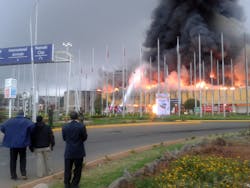Watching video of the fire that destroyed the airport terminal in Nairobi, Kenya and created chaos in East Africa’s flight schedules, reminded me of some of our own fire vulnerabilities at airports in the United States. And even though it no longer appears that a fuel leak started this particular fire, I thought that with the devastation from that airport fire fresh in everyone’s minds, it was a good time to talk about some simple safety precautions that could prevent a conflagration from occurring at one of our airports.
Many GSE operators store vehicles overnight, especially in the winter months, inside the baggage room or in other areas inside the terminal building. Often times, the equipment is fueled before being parked indoors.
Here are some of the problems that I have seen on airport audits:
- The number of vehicles stored indoors exceeding the number authorized by the airport to be stored in that area.
- In other airports, I have seen vehicles parked in locations that are not authorized at all.
- I have also seen fuel spills inside the building which adds to the hazard.
Operators should review their airport’s requirements to make sure that vehicle storage in enclosed areas – especially in the terminal – is done only in accordance with the airport’s rules.
In addition, in locations where vehicles are expressly allowed, operators should regularly review fire safety requirements to make sure that they are in compliance and adequate to extinguish a fire if one were to start. Specifically, operators should ensure that the correct type of fire extinguishers, in the number required, are available and in their proper location.




